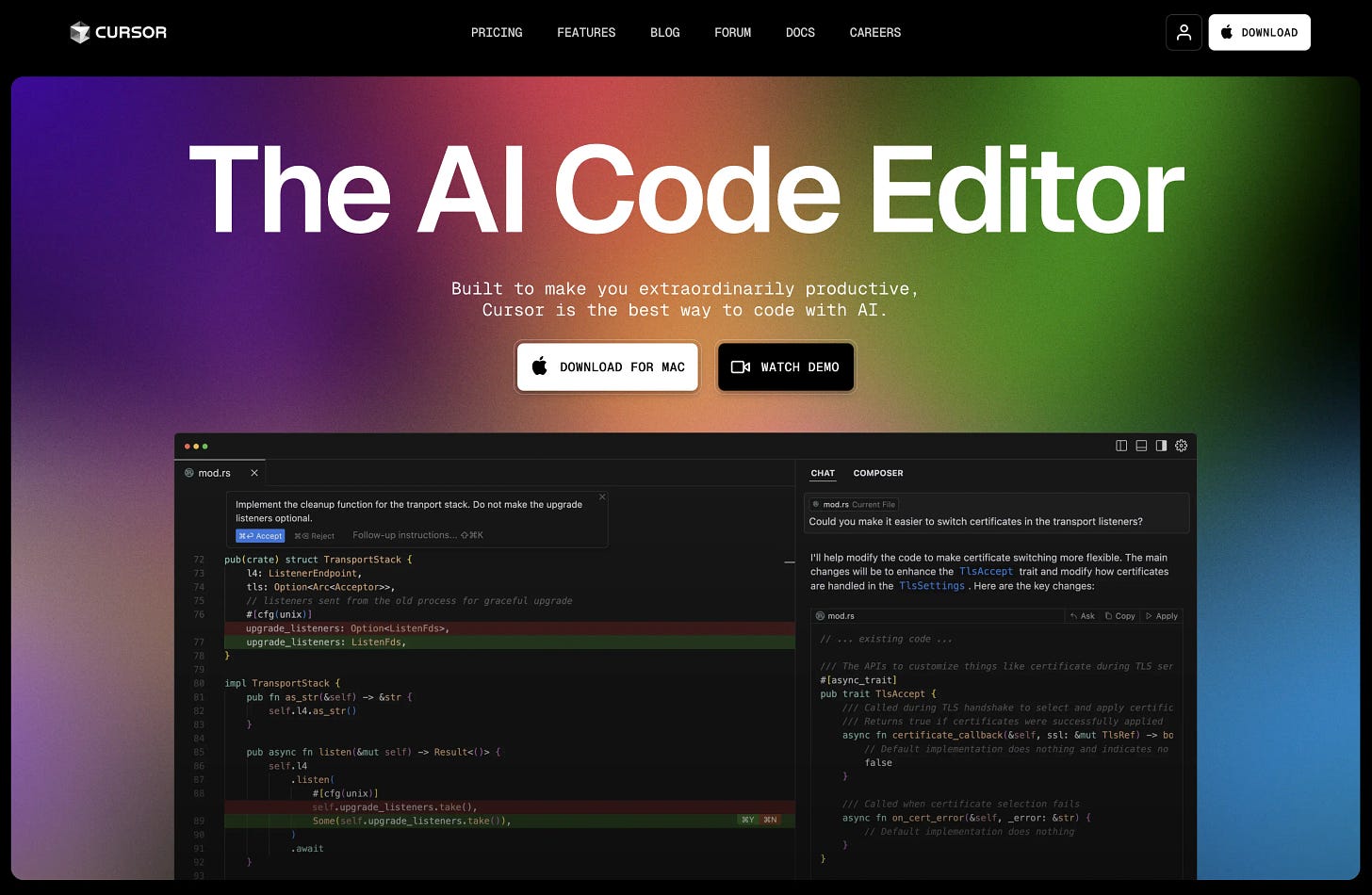AI: 2 Years to Ship? Try 2 Weeks
The latest AI tools I'm using to ship my way to freedom before my next paycheck
I recently replied to a BowTied Bull questioner who had half-swallowed the black pill on the impact of AI on the market for software engineers.
As always, no black pills. Despair is demonic.
And in this case, it is not hard to put down the pill box.
The SaaS which five years ago took 2 years to build, I can now build in 2 weeks.
Read that again.
2 years, is now down to 2 weeks.
Now like the saying goes, you can never cross the same river twice, because both you and the river are different. I’m a much better engineer now than 5 years ago. But the tools are hugely powerful in the right hands.
AI in the hands of 10x engineers is a sight to behold.
Even, among business founders, I've seen some get an MVP out in a month that previously they would have barely been able to scrap a wireframe design together on Figma in the same amount of time.
The era of only needing 2 weeks to ship is here.
This post will go in depth into my latest workflow leveraging AI tools which has let me ship two full SaaS apps to production in under a month.
For those planning your escape, this may be among the highest ROI posts you read this year. Pour a cup of coffee and sit down for this.
Hire me as CTO or tech lead for your next project.
Focus on growing the business, never worry about the tech again.
Slide into my DMs on X or Substack. Select portfolio at Deca Labs.
2 years down to 2 weeks
5 years ago I did one of my first wifi-money SaaS startups. It took 2 years to get to production and in front of customers.
Part of this was my inexperience at the time, but part of it was having to do every single thing by hand.
Want to crawl a website? Go read Selenium docs, fiddle around with the debugger and test.
Want to extract text from a PDF? Go read Tesseract docs, spend a week getting it setup, tune the weights and do more tests.
Want to crawl in parallel? Weeks doing load testing and fixing batch management.
Want to scale beyond prototype? Read docs and eventually realize you need to add MySQL indexes.
Want to deploy with memory limits? Spend weeks converting from docker-compose to Docker Swarm, realize your boxes Docker version broke your secrets management, finally get it working.
Want to serve https? Figure out Traefix proxy router and
Want to handle auth? Setup an Authelia sidecar and figure out how to integrate it with your container & deploy setup.
Want to have a database backed feature flag abstraction and frontend? Spend a week building it from scratch.
... and on, and on
The pain from having to figure this all out from first principles resulted in [KtSaaS](https://ktsaas.io). I took everything I learned, and published a generic template anyone could use.
It worked, and still is not a bad template.
But, would I take that same approach today? Hell no.
Using today's AI tools, and a more batteries-included stack like Ruby-on-Rails, I can build the same SaaS but in 2 weeks instead of 2 years.
And this isn't in theory, this is in practice. I just did this twice in the past month.
I'm not kidding, you can escape.
Thank you to the readers who pay to make this newsletter possible.
Are you looking for 1:1 coaching (tech career, wifi-money, Canadian real estate)?
DM me on Substack or X with your proposed topic, I’ll let you know if I can help. $100 for 30 minutes of information you can trust.
Ready to turn your life around? Start here and report back your wins. It’s a growing club of winners, and we’re waiting for you to join.
– Fullstack
Level 1: Copilot Virgin
Github Copilot was one of the first AI coding products out of the gate in 2023.
I've written before about how I used it to work an extra consulting contract on top of my regular W2. In that case, the consulting company I was working for even covered the licence cost for me, so I didn't have to think about cost at all.
And generally, it worked well enough even with early ChatGPT-3.5 models to make me productive in Python which I had never used in a professional setting before.
The one thing that started to make my eyes wander was the new agent mode and diff UI that other AI coding products were launching with, and Copilot didn't clone until a year later.
Level 2: Cursor Creator
Beyond just asking ChatGPT conversation mode coding questions like a buffoon, you'll want AI tools which have a tighter integration into your codebase and development environment.
One of the first tools which made a big splash when it launched was a VS Code clone (literally, they forked it) called Cursor.
Cursor added a nice diff UI and chat sidebar, and over time have tuned their models or prompts to be shockingly effective.
For example, in an afternoon, I was about to write a Typescript CLI tool that extracted text from an input PDF file using Tesseract (a local OCR library). When I attempted this previously, it took 2 weeks.
After plowing away for a few hours though, you quickly start to hit API limits which gets pretty annoying. They have paid plans which expand your limits a bit and add some markup on top of base model prices, but I wanted to see what else was out there which might be cheaper.
Level 3: OSS Optimizor
Cursor hadn't even been out for more than a month or two when open source alternatives launched which let you use your own API key to a model provider and skip the Cursor markup.
Better yet, they were vanilla VS Code plugins, not an entirely new IDE app to download, so they work a bit easier with your existing workflow.
I snagged some API keys and initial credits for OpenAI ChatGPT, Anthropic Claude, Google Gemini, and xAI Grok models, and got to work.





